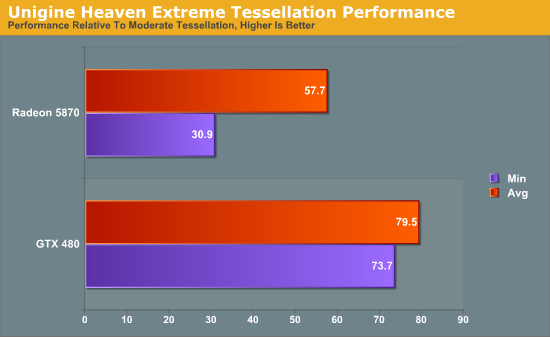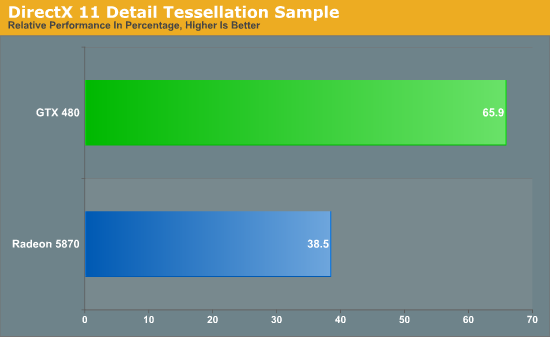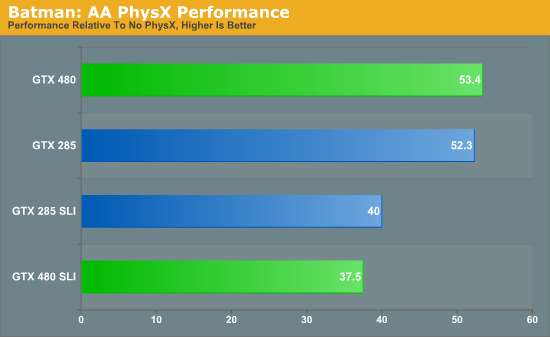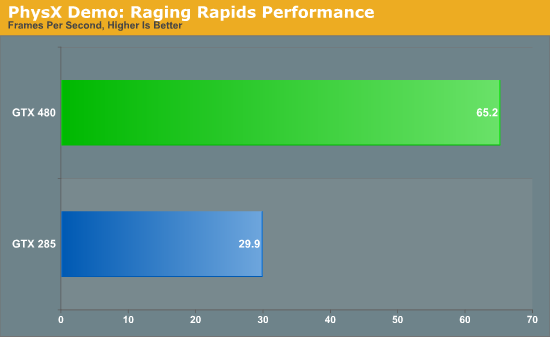NVIDIA’s GeForce GTX 480 and GTX 470: 6 Months Late, Was It Worth the Wait?
by Ryan Smith on March 26, 2010 7:00 PM EST- Posted in
- GPUs
Tessellation & PhysX
We’ll kick off our in-depth look at the performance of the GTX400 series with Tessellation and PhysX. These are two of the biggest features that NVIDIA is pushing with the GTX400 series, with tessellation in particular being the major beneficiary of NVIDIA’s PolyMorph Engine strategy.

As we covered in our GF100 Recap, NVIDIA seeks to separate themselves from AMD in spite of the rigid feature set imposed by DirectX 11. Tessellation is one of the ways they intend to do that, as the DirectX 11 standard leaves them plenty of freedom with respect to tessellation performance. To accomplish this goal, NVIDIA needs significantly better tessellation performance, which has lead to them having 14/15/16 tesselators through having that many PolyMorph Engines. With enough tessellation performance NVIDIA can create an obvious image quality improvement compared to AMD, all the while requiring very little on the part of developers to take advantage of this.
All things considered, NVIDIA’s claim of having superior tessellation performance is one of the easiest claims to buy, but all the same we’ve gone ahead and attempted to confirm it.
Our first tessellation test is the newly released Unigine Heaven 2.0 benchmark, which was released a few days ago. 2.0 added support for multiple levels of tessellation (with 1.0 having earned a reputation of using extreme levels of tessellation), which allows us to look at tessellation performance by varying tessellation levels. If the GTX 480’s tessellation capabilities are several times faster than the Radeon 5870’s as NVIDIA claims, then it should better handle the increased tessellation levels.
Since Heaven is a largely a synthetic benchmark at the moment (the DX11 engine isn’t currently used in any games) we’ll be focusing on the relative performance of cards to themselves in keeping with our editorial policy of avoiding synthetic GPU tests when possible.

Heaven: Moderate & Extreme Tessellation
Heaven has 4 tessellation levels: off, moderate, normal, extreme. For our test we’re using the moderate and extreme modes, comparing the performance of extreme as a percentage of moderate performance.

Starting with averages, the GTX 480 keeps 79% of its performance moving from moderate to extreme. On the Radeon 5870 however, the performance drop-off is much more severe, losing 42% of its performance to bring it down to 58%.
The minimum framerates are even more telling. The GTX 480 minimum framerates drop by 26% when switching to extreme tessellation. The Radeon 5870 is much worse off here, bringing in minimum framerates 69% lower when using extreme tessellation. From these numbers it’s readily apparent that the GTX 480 is much more capable of dealing with very high tessellation levels than the Radeon 5870 is.
Our second tessellation test is similar in nature, this time taken from one of Microsoft’s DX11 sample programs: Detail Tessellation. Detail Tessellation is a simple scene where tessellation plus displacement mapping is used to turn a flat rock texture in to a simulated field of rocks by using tessellation to create the geometry. Here we measure the average framerate at different tessellation factors (7 and 11) and compare the framerate at the higher tessellation factor to the lower tessellation factor.


Looking at just the averages (the framerate is rather solid) we see that the GTX 480 retains 65% of its performance moving from factor 7 to factor 11. The Radeon 5870 on the other hand only retains 38% of its performance. Just as what we saw in Unigine, the GTX 480 takes a much lighter performance hit from higher tessellation factors than the Radeon 5870 does, driving home the point that the GTX 480 has a much more powerful tessellator.
With the results of these tests, there’s no reason to doubt NVIDIA’s claims about GF100’s tessellation abilities. All the data we have points GF100/GTX 480 being much more powerful than the Radeon 5000 series when it comes to tessellation.
But with that said, NVIDIA having a more powerful tessellator doesn’t mean much on its own. Tessellation is wholly dependent on game developers to make use of it and to empower users to adjust the tessellation levels. Currently every DX11 game using tessellation uses a fixed amount of it, so NVIDIA’s extra tessellation abilities are going unused. This doesn’t mean that tessellation will always be used like this, but it means things have to change, and counting on change is a risky thing.
NVIDIA’s superior tessellation abilities will require that developers offer a variable degree of tessellation in order to fully utilize their tessellation hardware, and that means NVIDIA needs to convince developers to do the extra work to implement this. At this point there’s no way for us to tell how things will go: NVIDIA’s superior tessellation abilities could be the next big thing that seperates them from AMD like they’re shooting for, or it could be the next DirectX 10.1 by being held back by weaker hardware. Without some better sense of direction on the future use of tessellation, we can’t make any recommendations based on NVIDIA’s greater tessellation performance.
Moving on we have PhysX, NVIDIA’s in-house physics simulation middleware. After picking up PhysX and its developer AGEIA in 2008, NVIDIA re-implemented PhysX hardware acceleration as a CUDA application, allowing their GPUs to physics simulations in hardware. NVIDIA has been pushing it on developers and consumers alike with limited success, and PhysX only finally had a breakthrough title last year with the critically acclaimed Batman: Arkham Asylum.
With Fermi’s greatly enhanced compute abilities, NVIDIA is now pushing the idea that PhysX performance will be much better on Fermi cards, allowing developers to use additional and more complex physics actions than ever before. In particular, with the ability to use concurrent kernels and the ability to do fast context switching, PhysX should have a reduced degree of overhead on Fermi hardware than it did on GT200/G80 hardware.
To put this idea to the test, we will be using the Batman: Arkham Asylum benchmark to measure PhysX performance. If PhysX has less overhead on Fermi hardware then the framerate hit on the GTX 480 from enabling PhysX effects should be lower than the framerate hit on the GTX 285. For this test we are running at 2560x1600, comparing performance between PhysX being disabled and when it’s set on High.

If PhysX has less overhead on Fermi hardware, Batman is not the game to show it. On both the GTX 480 and the GTX 285, the performance hit on a percentage basis for enabling PhysX is roughly 47%. The GTX 480 may be faster overall, but it takes the same heavy performance hit for enabling PhysX. The SLI cards fare even worse here: the performance hit for enabling PhysX is 60% on both the GTX 480 SLI and the GTX 285 SLI.
PhysX unquestionably has the same amount of overhead on the GTX 480 as it does the GTX 285. If PhysX is going to take up less overhead, then from what we can gather it either will be a benefit limited to PhysX 3, or will require future PhysX 2.x updates that have yet to be delivered.
Or second PhysX test is a more generalized look at PhysX performance. Here we’re using NVIDIA’s Raging Rapids tech demo to measure PhysX performance. Raging Rapids is a water simulation demonstration that uses PhysX to simulate waves, waterfalls, and more. Here we are measuring the framerate in the demo’s benchmark mode.


Overall the Raging Rapids benchmark gives us mixed results. Out of all of the benchmarks we have run on the GTX 480, this is one of the larger performance jumps over the GTX 285. On the other hand, once we compensate for the GTX 480’s additional shaders, we end up with a result only around 10% faster than a strict doubling in performance. This is a sign of good scaling, but it isn’t a sign that the GTX 480 is significantly faster than the GTX 285 due to more efficient use of compute resources. Just having all of this extra compute power is certainly going to make a difference overall, but on an architectural level the GTX 480 doesn’t look to be significantly faster at PhysX than the GTX 285 on a per-clock/per-shader basis.











196 Comments
View All Comments
Ryan Smith - Wednesday, March 31, 2010 - link
My master copies are labeled the same, but after looking at the pictures I agree with you; something must have gotten switched. I'll go flip things. Thanks.Wesgoood - Wednesday, March 31, 2010 - link
Correction, Nvidia retained their crown on Anandtech. Even though some resolutions even on here were favored to ATI(mostly the higher ones). On Toms Hardware 5870 pretty much beat GTX 480 from 1900x1200 to 2560x1600, not every time in 1900 but pretty much every single time in 2560.That ...is where the crown is, in the best of the best situations, not ....OMG it beat it in 1680 ...THAT HAS TO BE THE BEST!
Plus the power hungry state of this card is just appauling. Nvidia have shown they can't compete with proper technology, rather having to just cram everything they can onto a chip and prey it works right.
Where as ATI's GPU is designed perfectly to where they have plenty of room to almost double the size of the 5870.
efeman - Wednesday, March 31, 2010 - link
I copied this over from a comment I made on a blog post.I've been with nVidia for the past decade. My brother built his desktop way back when with the Ti 4200, I bought a prefab with a 5950 ultra, my last budget build had an 8600 GTS in it, and I upgraded to the GTX 275 last year. I am in no way a fanboy, nVidia just has treated me very well. If I had made that last decision a few months later after the price hike, it would've definitely been the HD 4890; almost identical performance for ballpark $100 less.
I recently built a new high-end rig (Core i7 and all), but I waited out on dropping the money on a 5800 series card. I knew nVidia's new cards were on the way, and I was excited and willing to wait it out; I expected a lot out of them.
Now that they're are out in the open, I have to say I'm a little shaken. In many cases, the performance of the cards are not where I would've hoped they be (the general consensus seems to be 5-10% increase in performance over their ATI counterparts; I see that failing in many cases, however). It seems like the effort that nVidia put into the cards gave them lots of potential, but most of it is wasted.
"The future of PC gaming" is right in the title of this post, and that's what these cards have been built for. Nvidia has a strong lead over ATI in compute and tessellation performance now, that's obvious; however, that will only provide useful if and when developers decide to put the extra effort into taking advantage of those technologies. Nvidia is gambling right now; it has already given ATI a half-year lead on the DX11 market, and it's pushing cards that won't be fully utilized until who-knows-when (there's no telling when these technologies will be more widely integrated into the gaming market). What will it do in the meantime? ATI is already on it's way to producing its 5000-series refresh; and this time it knows the competition's performance.
I was hoping for the GTX 400s to do the same thing that the GTX 200s did: give nVidia back the high-end performance throne. ATI is not only competitive with it's counterparts, but it still has the 5970 for the enthusiast performance crown (don't forget Eyefinity!). I think nVidia made a mistake in putting so much focus into compute and tessellation performance; it would've been smarter to produce cards with similar die sizes (crappy wafer yields, anyone?), faster raw performance with tessellation/compute as a secondary objective, and more competitive pricing. It wouldn't have been a bad option to create a separate chip for the Tesla cards, one that focused on the compute performance while the GeForce cards focused on the rest.
I still have faith. Maybe nVidia will work wonders with the drivers and producing performance we were waiting for. Maybe it has something awesome brewing deep within its labs. Or maybe my fears will embody themselves, and nVidia is crossing its fingers and hoping for its tessellation/compute performance to give it the market share later on. If so, ATI will provide me with my pair of cards.
That was quite the rant; I wasn't planning on writing that much when I decided to comment on Drew Henry's (nVidia GM) blog post. I suppose I'm passionate about this sort of thing, and I really hope nVidia doesn't lose me after all this time.
Kevinmbaron - Wednesday, March 31, 2010 - link
The fact that this card comes out a year and a 1/2 after the the GTX 295 makes me sick. Add to that the fact that the GTX 295 actually is faster then the GTX 480 in a few benchmarks and very close in others is like a bad dream for nvidia. Forget if they can beat AMD, they can't even beat themselves. They could have did a die shrink on the GTX 295, add some more shadders and double the memory and had that card out a year ago and it would have crushed anything on the market. Instead they risked it all on a hair brained new card. I am a GTX 295 owner. Apperently my card is a all arround better card being it doesnt lag in some games like the 480 does. I guess i will stick with my old GTX 295 for another year. Maybe then there might be a card worth buying. Even the ATI 5970 doesn't have enough juice to justify a new purchase from me. This should be considered horrible news for Nvidia. They should be ashammed of themselves and the CEO should be asked to step down.ol1bit - Thursday, April 1, 2010 - link
I just snagged a 5870 gen 2 I think (XFX) from NewEgg.They have been hard to find in stock, and they are out again.
I think many were waiting to see if the GF100 was a cruel joke or not. I am sorry for Nivida, but love the completion. I hope Nvidia will survive.
I'll bet they are burning the midnight oil for gen 2 of the GF100.
bala_gamer - Friday, April 2, 2010 - link
Did you guys recieve the GTX480 earlier than other reviewers? There were 17 cards tested on 3 drivers and i am assuming tests were done multiple times per game to get an average. installing, reinstalling drivers, etc 10.3 catalyst drivers came out week of march 18.Do you guys have multiple computers benchmarking at the same time? I just cannot imagine how the tests were all done within the time frame.
Ryan Smith - Sunday, April 4, 2010 - link
Our cards arrived on Friday the 19th, and in reality we didn't start real benchmarking until Saturday. So all of that was done in roughly a 5 day span. In true AnandTech tradition, there wasn't much sleep to be had that week. ;-)mrbig1225 - Tuesday, April 6, 2010 - link
I felt compelled to say a few things about nvidia’s Fermi (480/470 GTX). I like to always start out by saying…let’s take the fanboyism out of the equation and look at the facts. I am a huge nvidia fan, however they dropped the ball big time. They are selling people on ONE aspect of DX11 (tessellation) and that’s really the only thing there cards does well but it’s not an efficient design. What people aren’t looking at is that their tessellation is done by the polymorh engine which ties directly into the cuda cores, meaning the more cuda cores occupied by shaders processing…etc the less tessellation performance and vice versa = less frames per sec. As you noticed we see tons of tessellation benchmarks that show the gtx 480 is substantially faster at tessellation, I agree when the conditions suite that type of architecture (and there isn’t a lot of other things going on). We know that the gf100(480/470gtx) is a computing beast, but I don’t believe that will equate to overall gaming performance. The facts are this gpu is huge (3billion + transistors), creates a boat load of heat, and sucks up more power than any of the latest dual gpu cards (295gtx, 5970) came to market 6 months late and is only faster than its single gpu competition by 10-15% and some of us are happy? Oh that’s right it will be faster in the future when dx11 is relevant…I don’t think so for a few reasons but ill name two. If you look at the current crop of dx11 games, the benchmarks and actual dx11 game benchmarks (shaders and tessellation…etc) shows something completely different. I think if tessellation was nvidia’s trump card in games then basically the 5800 series would be beat substantially in any dx11 title with tessellation turned on…we aren’t seeing that(we are seeing the opposite in some circumstances), I don’t think we will. I also am fully aware that tessellation is scalable, but that brings me to another point. I know many of you will say that it is only in extreme tessellation environments that we really start to see the nvidias card take off. Well if you agree with that statement then you will see that nvidia has another issue. The 1st is the way they implement tessellation in their cards (not very scalable imo) 2nd is, the video card industry sales are not comprised of high end gpus, but the cheaper mainstream ones. Since nvidia polymorph engine is tied directly to its shaders…u kinda see where this is going, basicly less powerful cards will be bottlenecked by their lack of shaders for tessellation and vice versa. Developers want to make money, the way they make money is selling lots of games, example crysis was a big game, however it didn’t break any records sales…truth of the matter is most people systems couldn’t run crysis. Now you look at valve software and a lot of their titles sale well because of how friendly it is to mainstream gpus(not the only thing but it does help). The hardware has to be there to support a large # of game sales, meaning that if the majority of parts cannot do extreme levels of tessellation then you will find few games to implement it. Food for thought… can anyone show me a dx11 title that the gtx480 handily beats the 5870 by the same amount that it does in the heaven benchmark or even close to that. I think as a few of you have said, it will come down to what game work better with what architecture..some will benefit nvidia(Farcry2..good example) others Ati (Stalker)…I think that is what we are seeing now. IMOP.S. I think also why people are pissed is because this card was stated to be 60% faster than the 5870. As u can see its not!!
houkouonchi - Thursday, April 8, 2010 - link
Why the hell are the screenshots showing off the AA results in a lossy JPEG format instead of PNG like pretty much anything else?dzmcm - Monday, April 12, 2010 - link
I'm not familiar with Battleforge firsthand, but I understood it uses HD Ambient Occlusion wich is a variation of Screen Space Ambient Occlusion that includes normal maps. And since it's inception in Crysis SSAO has stood for Screen Space AO. So why is it called Self Shadow AO in this article?Bit-tech refers to Stalker:CoP's SSAO as "Soft Shadow." That I'm willing to dismiss. But I think they're wrong.
Am I'm falling behind with my jargon, or are you guys not bothering to keep up?